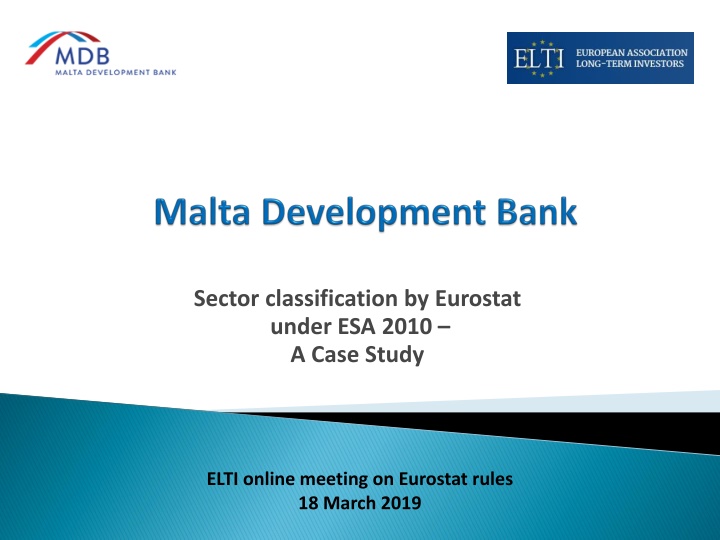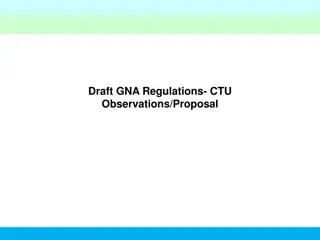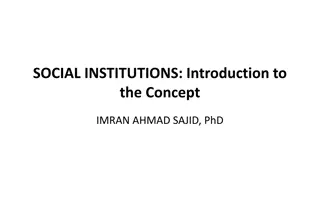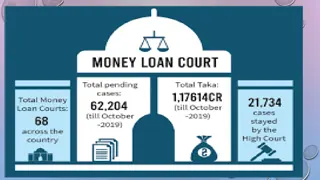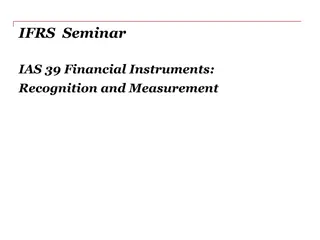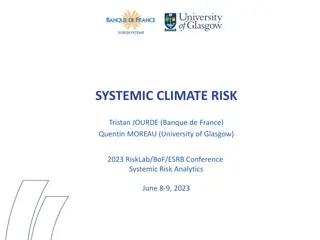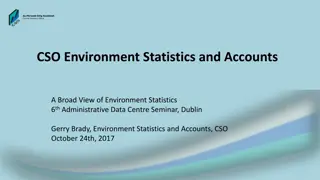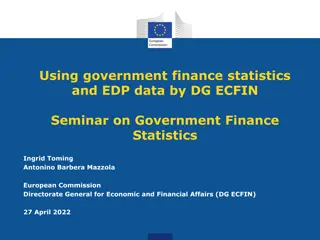Eurostat Classification and Government Guarantees in Financial Institutions
In this case study, Eurostat's classification of the MDB outside the general government sector is explored. The focus is on government guarantees, financial intermediary risks, and the implications outlined in the Eurostat Manual on Government Deficit and Debt under ESA 2010. The MDB's position regarding reliance on government guarantees is also discussed in detail.
Download Presentation

Please find below an Image/Link to download the presentation.
The content on the website is provided AS IS for your information and personal use only. It may not be sold, licensed, or shared on other websites without obtaining consent from the author.If you encounter any issues during the download, it is possible that the publisher has removed the file from their server.
You are allowed to download the files provided on this website for personal or commercial use, subject to the condition that they are used lawfully. All files are the property of their respective owners.
The content on the website is provided AS IS for your information and personal use only. It may not be sold, licensed, or shared on other websites without obtaining consent from the author.
E N D
Presentation Transcript
Sector classification by Eurostat under ESA 2010 A Case Study ELTI online meeting on Eurostat rules 18 March 2019
In June 2016, Bill on MDB Act was published after extensive consultations with Commission and Eurostat In August 2016, Commission published decision that MDB is in line with State Aid rules and in conformity with internal market. In August 2016 Eurostat informed National Statistics Office that MDB should be classified outside general government sector. In May 2017, Parliament passed MDB Act which came into force in December 2017. 2
Malta Government placed top priority that MDB is structured in such manner to ensure classification outside general government sector. Eurostat classified MDB under Other Financial intermediaries, except insurance corporations and pension funds (subsector 125) Eurostat reserves right to review its opinion should reality be different from MDB business plans and projections. 3
Eurostat Manual on Government Deficit and Debt under ESA 2010 (2016 edition) Part I.5 - Financial intermediation and risks exposure; Government guarantees on assets and liabilities (Par 15 21) Part I.6.6 - Entities having the features of captive financial institutions (Par 38 51) 4
Manual paragraph 18 states : In some cases, government may grant explicit guarantees institutions on their liabilities. Such government guarantees transfer all or part of the ultimate risk. to financial 5
MDB position: based on the MDB business plan, MDB does not intend to resort significantly to government guarantees on liabilities. MDB bond issues for local market Not guaranteed by government. bilateral loans from other institutions depending on negotiations. 6
Manual paragraph 16 states: ifgovernment bears directly most of the risks and rewards on a part of the activity of a public financial corporation, this activity (i.e. related stock and flows) should be re-routed through the government sector 7
Manual paragraph 20 states that: In some cases, government may also grant guarantees to a public financial unit directly on all or almost all of its assets...As a result, any losses on non-performing loans or other problematic assets are automatically (in some cases only partially or with caps/floors) covered by government..... Such units are not considered placing themselves at risk" on assets covered by the government guarantee, i.e. government de facto overtakes the credit risks. a transfer from 8
Manual paragraph 21 states that: When such guarantees (not only on all or almost all the assets) effectively transfer the risks and rewards to government, then the economic owner of the guaranteed assets is the government. 9
MDB position: MDB Act provides that the government guarantee will be up to 100 percent as distinct from 100% . the amount of the government guarantee, in absolute euro terms or in percentage, shall be determined through an MOU between the Government and the MDB, revised at five-yearly intervals. MDB s business plan envisages that reliance on government guarantees will account for less than one half of the MDB s total lending operations. 10
Manual paragraph 44 states that: As regards the constraints on assets side, it means that the parent/controlling unit imposes the conditions in which the unit may act, without the possibility of changing them (or very marginally) by its own initiative. For instance, the nature of the assets it can hold, the type and size of its intervention, the return on some assets, and the characteristics of the beneficiaries of the activity of the unit and other conditions are precisely defined by a controlling unit with no room of manoeuvre, or very little, if any, left to the unit. 11
MDB position: MDB Act explicitly stresses the independence and autonomy of MDB and underlines that the Bank shall operate at arm s length from the Government. For instance, the Act states that The Bank, its Chairperson, directors, officers and staff shall exercise their mandate under this Act independently and in an autonomous manner, and shallnot seek nor receive instructions from any authority, public or otherwise, or from any other institution. Public service employees and members of Parliament are precluded from appointment on the MDB Board of Directors. 12
Manual paragraph 44 further states that: if most of the loans (in number or in principal amounts) granted by such unit (or of its investments in other financial instruments) need an ex-ante authorisation from the controlling unit, the assets are considered to be under control of the latter and the unit would actually have the features similar to a captive financial institution . 13
MDB position: MDB will not be seeking any ex-ante authorisation from the Government on its lending or investment operations. Indeed, in terms of the MDB Act, it is precluded from doing so. MDB s lending strategy will be decided solely by the Board of Directors. 14
Manual paragraph 45 states: Government controlled entity with the characteristics of a captive financial institution may be for instance a public unit which have been entrusted by government to carry out activities in the context of public policies, generally limited to some precise tasks ......The government controlled unit would be obliged to conduct its interventions within a narrow framework defined by government, even if government would not necessarily approve/determine every single allocation of assets to every single beneficiary, which however may be frequently the case for operations of a significant size. have to formally 15
MDB position: MDB s remit is not limited to a narrow framework defined by the government. in terms of MDB Act, the MDB mandate covers a wide range of possible operations where there is market failure (SMEs and Infrastructure Projects) subject to the conditions specified in the Act to ensure compliance with EU state aid rules. 16
Manual paragraph 46 states: ...the unit would not be able to borrow without the authorisation of the parent unit, or would mainly be financed by the parent unit or, in some cases, would have most of its borrowing explicitly guaranteed by its parent unit. Under these conditions, the unit would not be in a position to decide by itself on the resources which could allow it to extend the scope of its activities or reorganise its interventions. 17
MDB position: No prior authorisation from the government is needed for the MDB to conduct its borrowing operations. In fact, the MDB Act prohibits the MDB from doing so. All borrowing powers are vested in the Board of Directors. Other than the equity capital injection, the MDB will not be relying on the Government for any of its financing requirement. The MDB s funding will largely take the form of long term bilateral loans from financial institutions, public issuance of bonds and some short term credits from the market. Less than half of the MDB s borrowing is expected to be guaranteed by Government. 18
Manual paragraph 49 states: An important feature is that generally government does not provide the funds with the aim to get a market rate of return, but gives priority to the fulfilment of some of its own policy objectives. Under these conditions, the government-controlled unit would not have to ensure a sufficient rate of return for facing a market cost of borrowing, as a normal financial institution would do. 19
MDB position: Whereas the overriding objective of the MDB, like all other EU NPBs, is public policy goals rather than profit-maximisation, the MDB is required by the MDB Act to operate in accordance with good commercial and economic practice . MDB Act further provides that The Bank shall be guided by sound banking principles in its operations . 20
Manual paragraph 51 states: Finally, there might be cases where the unit could borrow on markets but without any explicit government guarantee on its debt instruments. However, due to the narrow control of government on its activity and because of the crucial role of the unit in the context of important government policy, it is likely that the investors would have no doubt on a government support if needed and would price this situation. In case the unit would not cover the market cost of its borrowing without permanent support from government (which would appear in form of subsidies for off- setting the gap between asset interest and liability interest, compensating some administrative costs, covering losses, etc.), this unit should be classified in the government sector. 21
MDB position: The MDB refinancing rate is set at an adequate margin of at least 100 basis points above the base rate published by the European Commission in terms of Commission Regulation 271/2008 in respect of reference rates and discount rates. Where revenue stream of project falls short of required level for full servicing of MDB loan commitments, MDB will try to blend own resources with EU Structural Funds to cover shortfall, within the Investment Plan for Europe framework. 22
Czech Export Bank - CEB (6 June 2014): Pre-2013, CEB was classified outside government. Both Czech statistics authority and Eurostat classified CEB as general government; Liabilities are fully guaranteed by government Losses on subsidised operations borne by Govt. Not placing itself at risk Financing mainly from government Government control of Supervisory Board Government control on assets Very limited independence of decisions re corporate policy (re granting of loans, selection of beneficiaries) 23
Strategic Banking Corporation of Ireland (23.3.15) Irish CSO classified SBCI as public financial corporation. Eurostat classified SBCI as general government. Functions are quite limited in nature (loans to SME) Government controls assets of SBCI SBCI borrowing is fully guaranteed by government Part of borrowing is from government unit (NPFR). SBCI not placing itself at risk. Government controls liabilities of SBCI. 24
SNCI of Luxembourg (27 August 2014) Both Eurostat and Luxembourg s STATEC classified SNCI as part of general government. Government fully guarantees securities issued by SNCI and deposits linked to lending. SNCI not placing itself at risk. Limited range of activities. Strictly influenced and monitored by Govt. Board of Directors composed of Govt officials. SNCI not expected to behave as normal commercial entity. 25
Kredex Fund of Estonia (4 August 2014) Prior to 2013, Kredex was classified outside general government. In 2014, Eurostat reclassified it within Govt. Limited autonomy (Minister decides types of support granted annually and conditions). Intervenes within limited framework defined by Government. Kredex Council composed of Govt officials. Govt bears most of risks and covers losses. 26
Eximbank of Hungary (Feb 2016) In 2016, Eximbank was reclassified within general government Liabilities are fully guaranteed by the government Supervisory Board composed of one delegate from Government Limited autonomy Limited range of activities Eximbank not expected to behave as normal commercial entity (no expectation of a market rate of return on equity) Govt bears most of risks and covers losses. 27
Main issues determining NPB classification: Governance structure especially extent of Government control on decision-making: composition of Board government officials? Constraints on assets and liabilities, especially: limitations on NPB s mandate reliance on funding from government extent of risks assumed by NPB vs heavy dependence on government guarantee. Nature of business model, especially: are operations prone to loss-making? what extent of sound banking business? 28
Eurostat sector classification has introduced an element of uncertainty on future of NPBs rerouting has very adverse EDP implications. Certain Manual provisions might put pressure on new NPBs to depart somewhat from the traditional development banking model, especially re extent to which NPBs can rely on unconditional full government guarantee without risking re-routing to general govt. If a NPB seeks to avoid high reliance on Govt guarantee, it risks falling outside traditional definition of NPBs (at least 90% guaranteed) 29
This presentation is based on the 2016 edition of the Eurostat Manual on Government Deficit and Debt under ESA 2010 Eurostat is currently discussing with the national statistical competent authorities about the possibility of reviewing the rules to improve clarity 30
